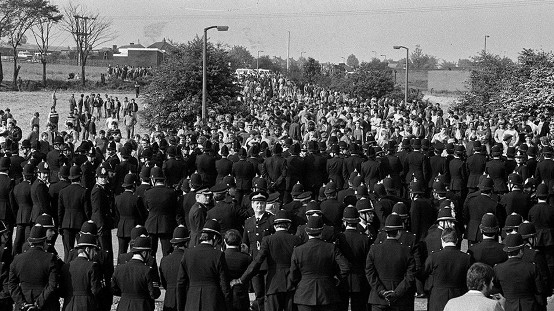Thirty years sounds like a long time. Still The Enemy Within makes that generational gap all but dissolve, using stirring archival footage and revealing interviews with the miners of the 1984 strike. We gradually come to realise, over the course of this inspirational – and enraging – documentary, that the weight is one we’ve all been carrying, ever since the close of those twelve months of tears, turmoil and toil. Some of us may have just been born a little too late to realise it.
Directed by Owen Gower, his first full-length feature, the film gives us an unprecedented amount of interview footage from those at the heart of the strike such as Paul Symonds, Steve Hammill, and Norman Strike (yes, that’s really his surname), which acts as the heart of the documentary. They rattled the political structures of the United Kingdom, even plunging themselves into an arguably self-engineered Winter of Discontent, but every step of the way, the movie shows us – with stunning footage – that they always had a point. Historic events during the strike, such as the Battle of Orgreave, are documented with no cuts and no misdirection. We see the brutality that the police and Thatcher’s government bring down upon the miners. While the doc most definitely takes sides with the miners, there has been no other piece of work so far that has made this conflict feel so alive and, most crucially, relevant to our own day and age.
But it’s understandable that there’s not much in the way of an alternative viewpoint presented. The film, for all its exemplary documentary groundwork, does not feature any politicians or speakers from the opposing side to the strikers. Still The Enemy Within, as a result, may come off as a back-slapping block party that congratulates itself despite its own defeat (and one that probably danced into the early hours on the night of Thatcher’s death), but that is far from the point. The film doesn’t smack of wistful, near-indulgent nostalgia of a war well fought, nor does it feel like puppy-whipped defeat; it lives very much in the here and now, noting the harm that has come from the eighties and from the grey-and-cobblestoned mindset of Thatcher’s Britain. You may think that there’s not much for you here if you were, or still are, a supporter of Thatcher’s policies, but that’s not true; what’s told in detail are deeply human stories any lover of cinema can appreciate. Like many real-world struggles of us-and-them, the strike is served well by the screen; in often excruciating detail, we’re there on the fields of Orgeave, shoulder-to-shoulder with police and miners alike, caught right in the middle of one of the most pivotal days in Twentieth-Century Britain. What was it like to live then? Still the Enemy Within gives us a good idea. It’s a lot like now.
In its closing moments, the grainy video of the eighties footage rapidly evolves before our eyes into the high-pixel handheld hues of the present, coming with a sudden realisation; nothing’s changed. Not really. Our father’s problems are now our own, albeit in different guises. This film clearly shows us the connective tissue between what seems like ancient history, and today’s – and tomorrow’s – increasingly grim outlook. It occurs that we still need to do something to stop the hurt that began a whole world ago. But what something? Can, or more importantly, will Britain get itself off its numb behind and act toward something it believes in once more? This film is perhaps as good a something as we can hope for right now.


